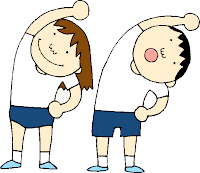It is important that students do a warm-up before starting daily physical activities. A proper warm-up sets the tone for the class and reduces the risk of injury during an activity.To warm up, students should participate in some low-intensity aerobic activity, such as brisk walking.Using the large muscles and gradually increasing speed and intensity in this type of activity gradually increases the heart rate and blood flow to the muscles. During the warm-up, it is important to follow up with stretches that move the joints through their full range of motion. Stretches such as arm circles and flexing and extending of the arms and legs are helpful.
Cool-down
 After physical activity, a cool-down period involving a more gentle activity helps the heart and body to return to their normal state. Slow-moving activities and stretches also help normalize the blood flow to the muscles and improve flexibility.The cooldown activities concentrate on unhurried, slow stretching. Because the muscles are warm during stretches, the risk of injury is reduced. Stretches should include all the major muscle groups, starting with the largest muscles. Each stretch should be held without bouncing for 15–30 seconds. Stretching should be imaginative and creative. Students can “reach for the sky”, or pretend to be a tree that is growing, or stretch their arms out as “wide as a wall”. The cool-down can also prepare students for the transition back to less-active activities.
After physical activity, a cool-down period involving a more gentle activity helps the heart and body to return to their normal state. Slow-moving activities and stretches also help normalize the blood flow to the muscles and improve flexibility.The cooldown activities concentrate on unhurried, slow stretching. Because the muscles are warm during stretches, the risk of injury is reduced. Stretches should include all the major muscle groups, starting with the largest muscles. Each stretch should be held without bouncing for 15–30 seconds. Stretching should be imaginative and creative. Students can “reach for the sky”, or pretend to be a tree that is growing, or stretch their arms out as “wide as a wall”. The cool-down can also prepare students for the transition back to less-active activities. 